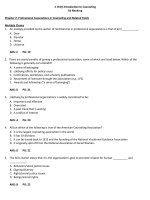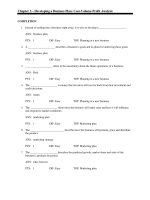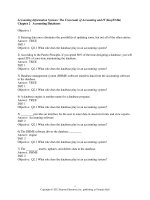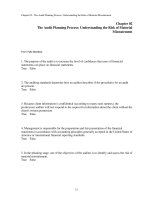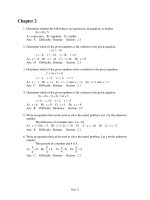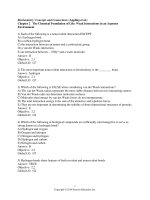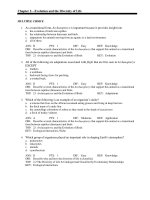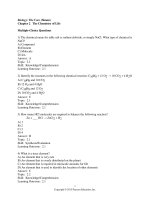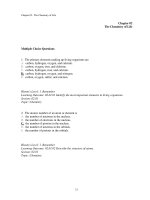Enhanced microsoft office 2013 illustrated fundamentals 1st edition hunt test bank
Bạn đang xem bản rút gọn của tài liệu. Xem và tải ngay bản đầy đủ của tài liệu tại đây (264.33 KB, 14 trang )
Name:
Class:
Date:
Access 2013 Unit J: Creating a Database
1. A database is an organized collection of unrelated information.
a. True
b. False
ANSWER:
False
POINTS:
1
REFERENCES:
Access 254
LEARNING OBJECTIVES: ENHO.HUNT.16.001 - Define database, table, field, record, form, and query
2. A query extracts data from one or more database tables according to criteria that you set.
a. True
b. False
ANSWER:
True
POINTS:
1
REFERENCES:
Access 254
LEARNING OBJECTIVES: ENHO.HUNT.16.002 - Name and describe common database objects in Access
3. A relational database contains only one table.
a. True
b. False
ANSWER:
False
POINTS:
1
REFERENCES:
Access 254
LEARNING OBJECTIVES: ENHO.HUNT.16.001 - Define database, table, field, record, form, and query
4. A form is a summary of database information specifically designed for printing.
a. True
b. False
ANSWER:
False
POINTS:
1
REFERENCES:
Access 254
LEARNING OBJECTIVES: ENHO.HUNT.16.002 - Name and describe common database objects in Access
5. The column headings in a database table are called field names.
a. True
b. False
ANSWER:
True
POINTS:
1
REFERENCES:
Access 254
LEARNING OBJECTIVES: ENHO.HUNT.16.001 - Define database, table, field, record, form, and query
6. You can save a table in Datasheet view by clicking the Save button on the Quick Access toolbar.
a. True
b. False
ANSWER:
True
Cengage Learning Testing, Powered by Cognero
Page 1
Name:
Class:
Date:
Access 2013 Unit J: Creating a Database
POINTS:
1
REFERENCES:
Access 258
LEARNING OBJECTIVES: ENHO.HUNT.16.003 - Create and save a table in Datasheet view
7. When you save a database, all of the database objects within it are automatically saved too.
a. True
b. False
ANSWER:
False
POINTS:
1
REFERENCES:
Access 258
LEARNING OBJECTIVES: ENHO.HUNT.16.003 - Create and save a table in Datasheet view
8. To add a field to a table, you need to specify its data type.
a. True
b. False
ANSWER:
True
POINTS:
1
REFERENCES:
Access 258
LEARNING OBJECTIVES: ENHO.HUNT.16.004 - Specify or change the data type for a field
9. It is easier to add fields to new or existing tables in Datasheet view.
a. True
b. False
ANSWER:
False
POINTS:
1
REFERENCES:
Access 260
LEARNING OBJECTIVES: ENHO.HUNT.16.005 - Add fields in Design view
10. In Design view, you use a grid to enter fields and specify field data types.
a. True
b. False
ANSWER:
True
POINTS:
1
REFERENCES:
Access 260
LEARNING OBJECTIVES: ENHO.HUNT.16.006 - Specify data types in Design view
11. Tables, forms, queries, and reports are program components called objects. __________________________
ANSWER:
True
POINTS:
1
REFERENCES:
Access 254
LEARNING OBJECTIVES: ENHO.HUNT.16.002 - Name and describe common database objects in Access
12. Access is a database management system. __________________________
ANSWER:
True
Cengage Learning Testing, Powered by Cognero
Page 2
Name:
Class:
Date:
Access 2013 Unit J: Creating a Database
POINTS:
1
REFERENCES:
Access 254
LEARNING OBJECTIVES: ENHO.HUNT.16.001 - Define database, table, field, record, form, and query
13. Each row in a database table is called a(n) record. __________________________
ANSWER:
True
POINTS:
1
REFERENCES:
Access 254
LEARNING OBJECTIVES: ENHO.HUNT.16.001 - Define database, table, field, record, form, and query
14. A(n) form extracts data from one or more database tables. __________________________
ANSWER:
False - query
POINTS:
1
REFERENCES:
Access 254
LEARNING OBJECTIVES: ENHO.HUNT.16.002 - Name and describe common database objects in Access
15. Each text box in a(n) form corresponds with a field in a table. __________________________
ANSWER:
True
POINTS:
1
REFERENCES:
Access 254
LEARNING OBJECTIVES: ENHO.HUNT.16.002 - Name and describe common database objects in Access
16. Creating a database from a(n) template saves time since it contains many ready-made database objects.
__________________________
ANSWER:
True
POINTS:
1
REFERENCES:
Access 256
LEARNING OBJECTIVES: ENHO.HUNT.16.007 - Start Access
17. When you start working in a new database, a blank form opens in Datasheet view. __________________________
ANSWER:
False - table
POINTS:
1
REFERENCES:
Access 258
LEARNING OBJECTIVES: ENHO.HUNT.16.003 - Create and save a table in Datasheet view
18. Every table in a database must contain one field that is designated as the ID key field. __________________________
ANSWER:
False - primary
POINTS:
1
REFERENCES:
Access 258
LEARNING OBJECTIVES: ENHO.HUNT.16.008 - Set the primary key field
19. Every new table in Access includes a blank ID field which is automatically designated as the primary key field.
__________________________
ANSWER:
True
POINTS:
1
Cengage Learning Testing, Powered by Cognero
Page 3
Name:
Class:
Date:
Access 2013 Unit J: Creating a Database
REFERENCES:
Access 258
LEARNING OBJECTIVES: ENHO.HUNT.16.008 - Set the primary key field
20. Short Text is a(n) data type. __________________________
ANSWER:
True
POINTS:
1
REFERENCES:
Access 258
LEARNING OBJECTIVES: ENHO.HUNT.16.009 - Identify common data types
21. A database stores data in one or more spreadsheet-like lists called ____.
a. cells
b. records
c. tables
d. sheets
ANSWER:
c
POINTS:
1
REFERENCES:
Access 254
LEARNING OBJECTIVES: ENHO.HUNT.16.001 - Define database, table, field, record, form, and query
22. A database containing just one table is called a ____ database.
a. simple
b. relational
c. query
d. report
ANSWER:
a
POINTS:
1
REFERENCES:
Access 254
LEARNING OBJECTIVES: ENHO.HUNT.16.001 - Define database, table, field, record, form, and query
23. A database containing two or more tables of related information is called a ____ database.
a. simple
b. relational
c. complex
d. related
ANSWER:
b
POINTS:
1
REFERENCES:
Access 254
LEARNING OBJECTIVES: ENHO.HUNT.16.001 - Define database, table, field, record, form, and query
24. Records consist of ____, which contain information about one aspect of a record.
a. objects
b. reports
c. queries
d. fields
ANSWER:
d
POINTS:
1
REFERENCES:
Access 254
LEARNING OBJECTIVES: ENHO.HUNT.16.001 - Define database, table, field, record, form, and query
25. A(n) ____ is a user-friendly window that contains text boxes and labels that let users easily input data, usually one
record at a time.
a. object
b. report
Cengage Learning Testing, Powered by Cognero
Page 4
Name:
Class:
Date:
Access 2013 Unit J: Creating a Database
c. query
d. form
ANSWER:
POINTS:
REFERENCES:
LEARNING OBJECTIVES:
d
1
Access 254
ENHO.HUNT.16.001 - Define database, table, field, record, form, and query
26. A(n) ____ extracts data from one or more database tables according to criteria that you set.
a. object
b. report
c. query
d. form
ANSWER:
c
POINTS:
1
REFERENCES:
Access 254
LEARNING OBJECTIVES: ENHO.HUNT.16.001 - Define database, table, field, record, form, and query
27. A(n) ____ is a summary of information pulled from a database, specifically designed for printing.
a. object
b. report
c. query
d. form
ANSWER:
b
POINTS:
1
REFERENCES:
Access 254
LEARNING OBJECTIVES: ENHO.HUNT.16.001 - Define database, table, field, record, form, and query
28. As a ____ database management system, Access is particularly powerful because you can enter data once and then
retrieve information from all or several tables as you need it.
a. relational
b. simple
c. complex
d. manipulative
ANSWER:
a
POINTS:
1
REFERENCES:
Access 254
LEARNING OBJECTIVES: ENHO.HUNT.16.001 - Define database, table, field, record, form, and query
Cengage Learning Testing, Powered by Cognero
Page 5
Name:
Class:
Date:
Access 2013 Unit J: Creating a Database
29. In the accompanying figure, item 1 is the name of the only ____ in the database.
a. table
b. report
c. form
d. query
ANSWER:
a
POINTS:
1
REFERENCES:
Access 259
LEARNING OBJECTIVES: ENHO.HUNT.16.003 - Create and save a table in Datasheet view
30. In the accompanying figure, item 2 points to the ____.
a. record
b. report
c. ID field
d. ID
ANSWER:
c
POINTS:
1
REFERENCES:
Access 259
LEARNING OBJECTIVES: ENHO.HUNT.16.003 - Create and save a table in Datasheet view
31. In the accompanying figure, item 3 points to ____.
a. the fields in the table
b. field properties
c. all of the table types you can add to a datasheet
d. all of the data types you can apply to a field
ANSWER:
d
POINTS:
1
REFERENCES:
Access 259
LEARNING OBJECTIVES: ENHO.HUNT.16.003 - Create and save a table in Datasheet view
32. In the accompanying figure, the words Short Text refer to a ____.
a. record
b. data type
Cengage Learning Testing, Powered by Cognero
Page 6
Name:
Class:
Date:
Access 2013 Unit J: Creating a Database
c. field name
d. set of tables
ANSWER:
b
POINTS:
1
REFERENCES:
Access 259
LEARNING OBJECTIVES: ENHO.HUNT.16.009 - Identify common data types
33. You can create a database in Access by starting with a ____.
a. blank database
b. template
c. Both a and b.
d. None of the above.
ANSWER:
c
POINTS:
1
REFERENCES:
Access 256
LEARNING OBJECTIVES: ENHO.HUNT.16.010 - Create and save a blank database
34. In Datasheet view, the left pane below the Ribbon is called the ____ pane. It is where all database objects for the open
database are listed.
a. Navigation
b. Database
c. Objects
d. Data
ANSWER:
a
POINTS:
1
REFERENCES:
Access 256
LEARNING OBJECTIVES: ENHO.HUNT.16.010 - Create and save a blank database
35. In the accompanying figure, item 1 points to the____.
a. featured templates
b. recently opened databases
c. available template categories
d. Blank Database icon
ANSWER:
b
POINTS:
1
REFERENCES:
Access 257
LEARNING OBJECTIVES: ENHO.HUNT.16.007 - Start Access
Cengage Learning Testing, Powered by Cognero
Page 7
Name:
Class:
Date:
Access 2013 Unit J: Creating a Database
36. In the accompanying figure, item 2 points to the ____.
a. Office Default template
b. Access 2010 template
c. available template categories
d. Blank desktop database
ANSWER:
d
POINTS:
1
REFERENCES:
Access 257
LEARNING OBJECTIVES: ENHO.HUNT.16.010 - Create and save a blank database
37. In the accompanying figure, item 3 points to the ____.
a. featured templates
b. recently opened databases
c. saved template categories
d. Blank templates
ANSWER:
a
POINTS:
1
REFERENCES:
Access 257
LEARNING OBJECTIVES: ENHO.HUNT.16.007 - Start Access
38. To insert a new field, click an existing field and then click the Insert ____ button in the Tools group.
a. Rows
b. Fields
c. New Field
d. Columns
ANSWER:
a
POINTS:
1
REFERENCES:
Access 262
LEARNING OBJECTIVES: ENHO.HUNT.16.011 - Insert a field
39. If the ____ for Manager Last Name is Last Name, that means that only Last Name will be displayed as the field name
for this field in Datasheet view.
a. property
b. ID
c. nickname
d. caption
ANSWER:
d
POINTS:
1
REFERENCES:
Access 262
LEARNING OBJECTIVES: ENHO.HUNT.16.012 - Specify a caption for a field
40. Field ____ are data characteristics that dictate how Access stores, handles, and displays field data.
a. descriptions
b. names
c. properties
d. descriptors
ANSWER:
c
POINTS:
1
REFERENCES:
Access 262
LEARNING OBJECTIVES: ENHO.HUNT.16.013 - Change field properties
41. Field Size is an example of a field ____.
a. property
b. name
c. ID
d. caption
Cengage Learning Testing, Powered by Cognero
Page 8
Name:
Class:
Date:
Access 2013 Unit J: Creating a Database
ANSWER:
POINTS:
REFERENCES:
LEARNING OBJECTIVES:
a
1
Access 262
ENHO.HUNT.16.013 - Change field properties
42. When you click a field name to add a new record, the field ____ appears in the status bar.
a. description
b. type
c. size
d. category
ANSWER:
a
POINTS:
1
REFERENCES:
Access 264
LEARNING OBJECTIVES: ENHO.HUNT.16.014 - Add records in Datasheet view
43. A(n) ____ selector to the left of each record lets you select a record or records.
a. row
b. record
c. object
d. key
ANSWER:
a
POINTS:
1
REFERENCES:
Access 264
LEARNING OBJECTIVES: ENHO.HUNT.16.014 - Add records in Datasheet view
44. The data you enter in each field is called a field ____.
a. object
b. name
c. value
d. pane
ANSWER:
c
POINTS:
1
REFERENCES:
Access 264
LEARNING OBJECTIVES: ENHO.HUNT.16.014 - Add records in Datasheet view
45. You can edit text in fields by selecting it and typing new text or using the [____] key.
a. Data
b. Edit
c. Tab
d. Backspace
ANSWER:
d
POINTS:
1
REFERENCES:
Access 266
LEARNING OBJECTIVES: ENHO.HUNT.16.015 - Edit field values in Datasheet view
46. The border between field names is called the ____.
a. border separator
b. border divider
c. column separator
d. column divider
ANSWER:
c
POINTS:
1
REFERENCES:
Access 266
Cengage Learning Testing, Powered by Cognero
Page 9
Name:
Class:
Date:
Access 2013 Unit J: Creating a Database
LEARNING OBJECTIVES: ENHO.HUNT.16.016 - Resize columns in Datasheet view
47. _____ controls are devices for inputting data such as text boxes, list arrows, or check boxes.
a. Input
b. Form
c. Data
d. Text
ANSWER:
b
POINTS:
1
REFERENCES:
Access 268
LEARNING OBJECTIVES: ENHO.HUNT.16.017 - Create a form based on a table
48. The ____ data type assigns a unique number for each record in the table.
a. AutoNumber
b. UniqueNumber
c. AutoSet
d. AutoList
ANSWER:
a
POINTS:
1
REFERENCES:
Access 258
LEARNING OBJECTIVES: ENHO.HUNT.16.009 - Identify common data types
49. The field description appears in the ____ bar and helps users understand what type of data should be entered for the
field.
a. properties
b. status
c. address
d. navigation
ANSWER:
b
POINTS:
1
REFERENCES:
Access 260
LEARNING OBJECTIVES: ENHO.HUNT.16.018 - Add field descriptions
50. The Caption property appears in a form or in Datasheet view in place of the field ____.
a. icon
b. group
c. name
d. property
ANSWER:
c
POINTS:
1
REFERENCES:
Access 262
LEARNING OBJECTIVES: ENHO.HUNT.16.012 - Specify a caption for a field
51. You can use _____________________ to create a database to help you manage and track a large collection of related
data.
ANSWER:
Access
POINTS:
1
REFERENCES:
Access 254
LEARNING OBJECTIVES: ENHO.HUNT.16.001 - Define database, table, field, record, form, and query
52. To view different records you use buttons on the _____________________ bar.
ANSWER:
navigation
Cengage Learning Testing, Powered by Cognero
Page 10
Name:
Class:
Date:
Access 2013 Unit J: Creating a Database
POINTS:
1
REFERENCES:
Access 268
LEARNING OBJECTIVES: ENHO.HUNT.16.019 - View records using the Navigation bar
53. In _____________________ view, you can view records but cannot add, delete or edit records.
ANSWER:
Layout
POINTS:
1
REFERENCES:
Access 268
LEARNING OBJECTIVES: ENHO.HUNT.16.020 - Add records using Form view
54. To close Access, click Close on the _________________ tab.
ANSWER:
FILE
File
POINTS:
1
REFERENCES:
Access 268
LEARNING OBJECTIVES: ENHO.HUNT.16.021 - Close a database and exit Access
55. Text boxes, check boxes and list arrows are all ___________________ controls.
ANSWER:
Form
form
POINTS:
1
REFERENCES:
Access 268
LEARNING OBJECTIVES: ENHO.HUNT.16.017 - Create a form based on a table
56. Split view is a(n) _____________________ that displays the data entry form above the underlying datasheet.
ANSWER:
form
POINTS:
1
REFERENCES:
Access 268
LEARNING OBJECTIVES: ENHO.HUNT.16.020 - Add records using Form view
57. The simplest way to create a form is to click the Form button on the _______________ tab.
ANSWER:
CREATE
POINTS:
1
REFERENCES:
Access 268
LEARNING OBJECTIVES: ENHO.HUNT.16.017 - Create a form based on a table
58. Describe the difference between a simple and a relational database.
ANSWER:
A database containing one table is a simple database, and one that contains two or more
tables of related information is a relational database.
POINTS:
1
REFERENCES:
Access 254
LEARNING OBJECTIVES: ENHO.HUNT.16.001 - Define database, table, field, record, form, and query
TOPICS:
Critical Thinking
59. Describe how a database stores data.
Cengage Learning Testing, Powered by Cognero
Page 11
Name:
Class:
Date:
Access 2013 Unit J: Creating a Database
ANSWER:
A database stores data in tables, organized into rows and columns. Each column in the table
is a field, and each row in the table is a record. The columns are the values for a given piece
of information, such as a name, for all records. The rows represent all information for a given
record in the database, containing all values across all columns.
POINTS:
1
REFERENCES:
Access 254
LEARNING OBJECTIVES: ENHO.HUNT.16.001 - Define database, table, field, record, form, and query
TOPICS:
Critical Thinking
60. Describe the operations you can perform when a table is in Design view.
ANSWER:
You can set field properties and modify a table’s structure. You can also add field
descriptions or insert, delete, rearrange, or rename fields.
POINTS:
1
REFERENCES:
Access 260
LEARNING OBJECTIVES: ENHO.HUNT.16.005 - Add fields in Design view
TOPICS:
Critical Thinking
You work for a small pet shop and the store manager asks you to convert some of his paper records to an online system. A
simple database exists and the owner wants to add to the existing database.
61. Your supervisor wants a list of all the customers who purchased something recently from the store. Can you do this
with the current database design?
ANSWER:
Since the database only contains a single table, it is not likely that the current design tracks
that information. However, if the last sale information is part of the existing table, a query
may be able to answer the question.
POINTS:
1
REFERENCES:
Access 254
LEARNING OBJECTIVES: ENHO.HUNT.16.001 - Define database, table, field, record, form, and query
TOPICS:
Critical Thinking
62. Assuming that the existing database does not contain information related to sales in the table, how can you extend the
database to track the purchases for each customer?
ANSWER:
An additional table must be added to the database to track the information, transforming the
database into a relational design. The new table must be related to the original table in the
database.
POINTS:
1
REFERENCES:
Access 254
LEARNING OBJECTIVES: ENHO.HUNT.16.001 - Define database, table, field, record, form, and query
TOPICS:
Critical Thinking
63. Assuming you can extend the database with every possible need for the store, what objects must be included in
addition to the table(s) that make up the database?
ANSWER:
You must add query, form, and report objects to the database to make a complete application
that the store can use on a regular basis.
POINTS:
1
REFERENCES:
Access 254
Cengage Learning Testing, Powered by Cognero
Page 12
Name:
Class:
Date:
Access 2013 Unit J: Creating a Database
LEARNING OBJECTIVES: ENHO.HUNT.16.001 - Define database, table, field, record, form, and query
TOPICS:
Critical Thinking
You work in the human resources department of a large company that uses Microsoft Access to track information before
and after entering it into the company’s administrative system.
64. Your supervisor has asked you to add a field description to a field in the table. How can you do this?
ANSWER:
Open the table in Design view, choose the field name that needs a description, press [Tab]
twice to move to the Description text box, and then type a description. The description will
appear in the status bar.
POINTS:
1
REFERENCES:
Access 262
LEARNING OBJECTIVES: ENHO.HUNT.16.013 - Change field properties
TOPICS:
Critical Thinking
65. Your boss asks you for specific field values. What are field values?
ANSWER:
Field values are the data you enter into each field.
POINTS:
1
REFERENCES:
Access 264
LEARNING OBJECTIVES: ENHO.HUNT.16.014 - Add records in Datasheet view
TOPICS:
Critical Thinking
Match each item with a statement below.
a. Field names
b. Form
c. Report
d. Table
e. Query
REFERENCES:
Access 254
LEARNING OBJECTIVES: ENHO.HUNT.16.002 - Name and describe common database objects in Access
66. A set of criteria (conditions) you specify to retrieve data from a database.
ANSWER: e
POINTS: 1
67. A window that lets you view, enter, and edit data in a database one record at a time.
ANSWER: b
POINTS: 1
68. A summary of database information designed specifically for printing or distributing.
ANSWER: c
POINTS: 1
69. A list of data organized in rows (records) and columns (fields).
ANSWER: d
POINTS: 1
Cengage Learning Testing, Powered by Cognero
Page 13
Name:
Class:
Date:
Access 2013 Unit J: Creating a Database
70. The column headings in the table.
ANSWER: a
POINTS: 1
Cengage Learning Testing, Powered by Cognero
Page 14
